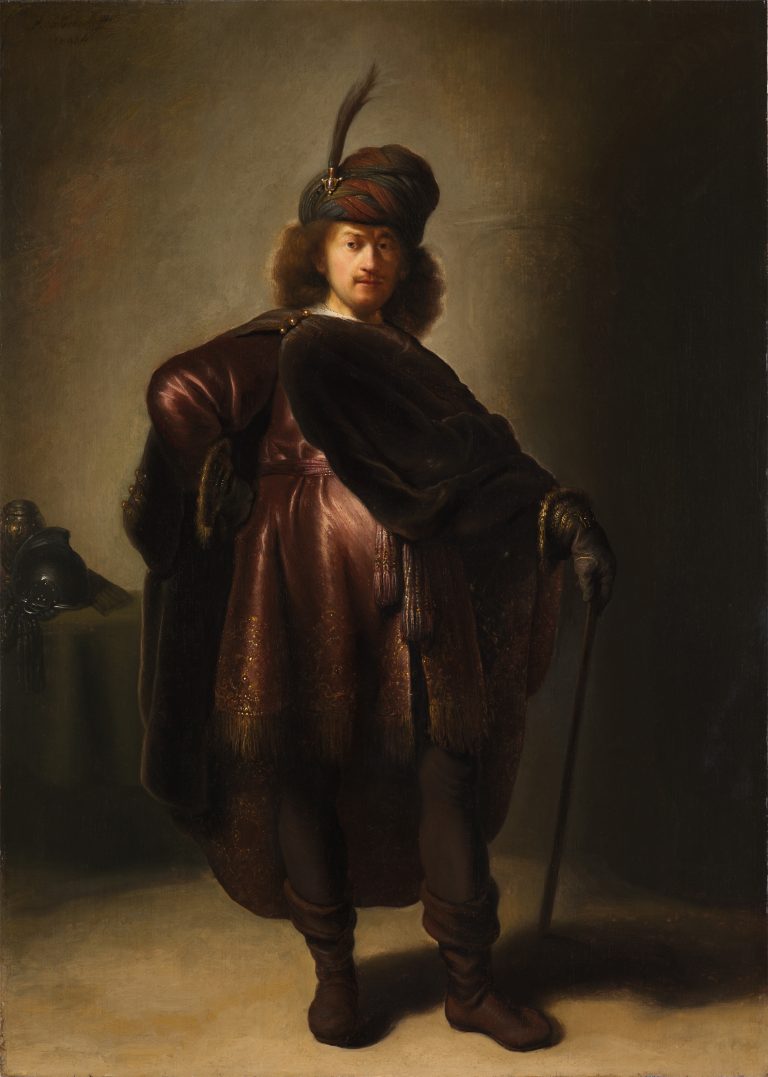Portrait of Rembrandt in Oriental Dress is a fascinating workshop copy by Isaac de Jouderville, executed toward the end of his apprenticeship with Rembrandt van Rijn (1606–69) from 1629 to 1631.1 Based on Rembrandt’s own full-length self-portrait, signed and dated 1631 in the Petit Palais in Paris (fig 1), Jouderville’s larger panel differs from its prototype in its cooler tonalities, more exaggerated chiaroscuro, and crisper silhouette. The most obvious difference between the two paintings, however, is that Jouderville’s version does not depict the large dog in the foreground of Rembrandt’s painting. Rembrandt added the curly, long-haired poodle at a later date, probably in 1633.2
As in Rembrandt’s original, Jouderville has portrayed the artist gazing at the viewer as he stands in contrapposto, with one hand resting on a cane and the other held akimbo. His fanciful costume includes a turban with a feathered aigrette, a velvet cloak closed at one shoulder with buttons, and a short silk tunic with golden brocade and fringe, tied by a sash at the waist.3 The fascination with exotic dress is evident in other works by Rembrandt from this period, as in Man in Oriental Costume (“The Noble Slav”), 1632, in the Metropolitan Museum of Art, and Daniel and Cyrus before the Idol Bel, 1633, in the J. Paul Getty Museum.4 Rembrandt, however, portrayed himself in oriental dress only on this one occasion.5
For most of its recorded history, Portrait of Rembrandt in Oriental Dress was considered to have been painted by the master. This attribution was based largely on its Rembrandtesque style and subject matter; the “signature” and date at the upper left—“Rembrandt ft. 1641”—were apparently added in the nineteenth century.6 In 1983, Ernst van de Wetering proposed that Portrait of Rembrandt in Oriental Dress was painted by an apprentice in Rembrandt’s workshop and suggested Jouderville as the most likely candidate.7 Van de Wetering’s proposal is convincing, for Jouderville’s Bust of a Young Man from the early 1630s in the National Gallery of Ireland, one of his few signed paintings, shares a number of stylistic features with the present work (fig 2). The overly emphasized highlights of the richly appointed fabric, the frizzy hair, and the thin contour of light around the figure leave little doubt that these two paintings are by the same hand.
The reason for Rembrandt’s choice to portray himself in exotic costume is difficult to ascertain.8 Nevertheless, it is significant that Rembrandt felt the composition was worthy of being replicated by a workshop apprentice.9 Because Rembrandt and Jouderville were in both Leiden and Amsterdam in 1631, it is also unclear in which city the prototype and this copy originated. In the summer of 1631, Rembrandt began his business arrangement with the Amsterdam dealer Hendrick van Uylenburgh, and he received a number of portrait commissions requiring his presence in Amsterdam.10 Scholars have suggested that Jouderville may have accompanied Rembrandt to Amsterdam as an assistant in Uylenburgh’s workshop, since the last payment receipt pertaining to Jouderville’s apprenticeship with Rembrandt is dated 19 November 1631.11
Jouderville’s Portrait of Rembrandt in Oriental Dress is a relatively rare example of the type of didactic exercises that must have been an integral part of Rembrandt’s workshop practice.12 We know that making painted copies after Rembrandt’s work, both as an exercise in imitation and as emulation of the master’s style, was an important part of Rembrandt’s method of instruction. Nevertheless, very few direct copies after his paintings, such as this one, survive.13 Jouderville was more likely to make variants of Rembrandt’s compositions. His Man in Oriental Costume (fig 3), for example, is loosely based on Rembrandt’s self-portrait in Paris (fig 1). A painting convincingly attributed to Jouderville, Bust of a Young Woman in Chapel Hill (RR-104, fig. 3), is similarly derived from one of Rembrandt’s paintings from the early 1630s, Portrait of a Girl Wearing a Gold-Trimmed Cloak, in the present collection (RR-104).14 Jouderville was also able to adapt pictorial elements in Rembrandt’s paintings to create his own independent works, as in his Minerva in Her Study in Denver, which draws freely on Rembrandt’s Old Woman Reading in the Rijksmuseum, Amsterdam.15
X-radiographs of Rembrandt’s Paris self-portrait have revealed that the master made a number of changes to this work. Initially he shortened the length of his legs and painted his feet anew, but then he added the poodle, which covers his feet.16 Because of the close correspondence between the longer legs in Rembrandt’s original and those in Jouderville’s copy, the Rembrandt Research Project concluded that Jouderville’s variant must represent the original appearance of Rembrandt’s painting. Thus, aside from its own intrinsic qualities, this portrait is a fascinating document of Rembrandt’s only known effort to paint a full-length self-portrait.
